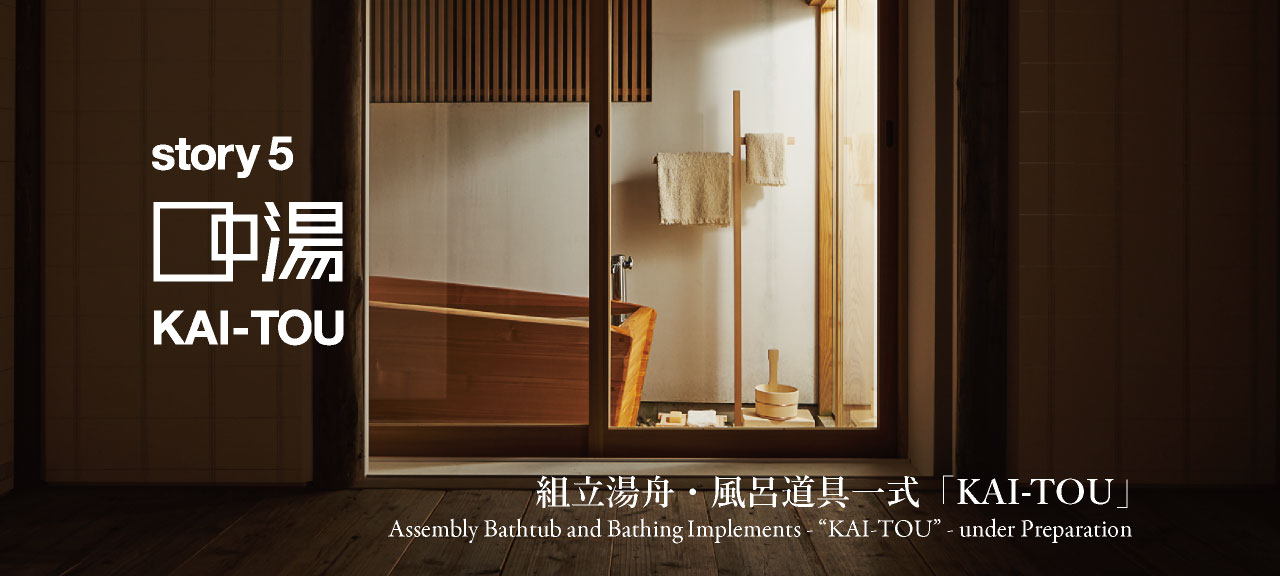

日本人にとって「風呂」に入ることは、本来、禊(みそぎ)であり、心身を清めるきわめて大事な営みです。全国各地に残る岩風呂・穴風呂・釜風呂・塩風呂から、『大内裏図考証』に描かれた天皇の御湯殿と調度品、東大寺にある日本最古の大湯屋、国宝飛雲閣の黄鶴台に連なる浴場、そして妙心寺や大徳寺の機能的な浴室まで、風呂に対する想いは脈々と受け継がれています。
江戸時代になると、竹の箍(たが)をはめた木樽に加熱装置がついた五右衛門風呂や鉄砲風呂が誕生します。それまで主流だった「蒸し風呂文化」は、一気に「湯に浸かる文化」へと移り変わり、人通りの多い街頭に設置する「辻風呂」や、人が集まる場所に風呂桶を担いて持っていく「荷い風呂」という移動式のミニ銭湯の発想がうまれます。さらには、船に風呂を乗せた舟風呂もあったとか。
KAIは、風呂文化をもっと気軽にとの思いで、持ち運べる組み立て式の湯舟を考えました。組み立て式にこだわった結果、形は<桶型>ではなく木の船をつくるときの技術を用いた<舟型>となりました。素材は椹(さわら)で、水に強く、割ったときの趣ある木肌が特徴です。また、両腕があたるところの絶妙な曲線の柔らかさにも注目ください。
For the Japanese, having a bath has conventionally signified ablutions and is an extremely important act of purification in both the physical and mental sense. Ranging from the rock baths, hole baths, steam baths and salt baths that survive around the country, to the emperor’s Oyudono bathroom and implements described in the “Daidairizu Kosho,” Japan’s oldest large bathhouse at Todaiji Temple, the bathrooms that extend to Kokakudai at the National Treasure Hiunkaku Pavilion, and the functional bathrooms of Myoshinji Temple and Daitokuji Temple, Japan has traditionally had sentimental attachment to baths and bathing.
The Edo Period witnessed the appearance of baths comprising round wooden barrels bound with hoops and fitted with heating units. Among these were “Goemonburo” (cast-iron tub that is heated from underneath using firewood) and “Teppoburo” (baths with metal pipes). The “steam bath culture” that had been the mainstream until then was suddenly superseded by a “culture of soaking in hot water”, and the concept of mobile mini public baths was born with the emergence of Tsujiburo bathtubs placed on busy roadsides and Ninaiburo bathtubs that were carried to the places where people gathered. There were even Funeburo bathtubs that were carried on boats.
In the hope of making bathing culture more accessible, KAI has devised the idea of a portable assembly bathtub Yubune. As a result of pursuing an assembly model, rather than a “barrel type,” we came up with a “boat type” by utilizing techniques for making wooden boats. It is made from Sawara cypress, which is resistant to water and has a distinctively tasteful bark when split. Also, please notice the gentle feel of the exquisitely shaped curves on the parts where you rest your arms.
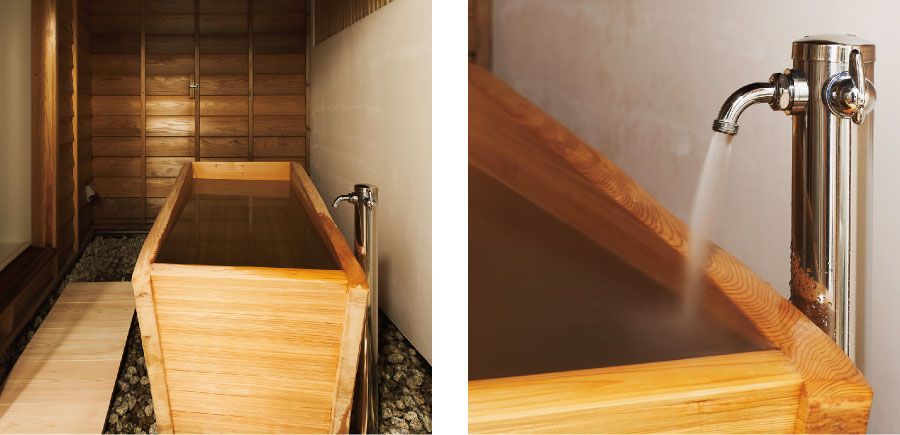
材を割る、鉋で挽く、刃物で削る、そして曲げるという桶物の技術は、紀元前2800年前後にエジプトで成立していて、その後、大陸から日本に入ったのは文字成立から鎌倉時代のあたりと言われています。入れ子桶、行器、手水桶、風呂桶、味噌桶、寿司桶など、私たちの暮らしに馴染みやすい桶は、江戸時代をピークに明治から大正まで日常生活のどこにでもあるものでした。ちなみに桶の基本構造は、複数の側板を持つこと、1枚板もしくは数枚の板によって集成された底板を持つこと、そして金属か竹か木などで成形された箍で強く固定することです。
木箱入りの風呂道具は、組立湯舟をつくったメンバーが、「湯舟の存在感や湯舟がある空間に似合った道具まで考え抜くことができたら、より豊かな“風呂”の楽しみ方を提供できるのではないか」という思いでつくらせていただきました。高野槙を用いた片手桶、丸湯桶、腰掛けと、木曽桧で作った石鹸台を箱入りでご用意いたしました。釘などはいっさい使わずに、木と木を仕口の方法で組み合わせる桶物の方法でつくっています。また、表面張力で横滑りをしてしまわないよう、底の部分の立ち上がりを少しだけ内側に入れるなど、道具ひとつひとつ細部までこだわりました。
組立湯舟・風呂道具一式 制作 中川周士
Techniques for making tubs, i.e. splitting wood, smoothing with a plane, cutting with a blade, and then bending, were established in Egypt some 2,800 years BC, and it is said they crossed over from the continent to Japan during the period between the adoption of written characters and the Kamakura Period. Tubs and pails, including nested bowls, lunch boxes, washroom pails, bath pails, miso vats, sushi rice bowls and so on, which are familiar fixtures in everyday life, were omnipotent implements of everyday life mainly during the period from Edo to the Meiji and Taisho eras. The basic structure of such pails and tubs comprises multiple side plates, a base plate composed of a single plate or laminated from multiple plates, and firm fixing by means of hoops made from metal, bamboo or wood,etc.
We decided to make the bathing implements in a wood box after one of the members who made the assembly bathtub said, “wouldn’t it be possible to provide a richer approach to enjoying the “bath” if we also devised tools suited to the presence of the bathtub and bathing space?” We have prepared a wood box that contains a hand pail, round pail and stool made from Japanese Umbrella pine and a soap stand made from Kiso cypress. We made these items through combining pieces of wood by the Shiguchi method without using any nails whatsoever, and by paying attention to every detail of the implements, for example, we slightly directed the rise of bases inwards to avoid side slip due to surface tension.
Assembly bathtub and bathing implements – Made by Shuji Nakagawa
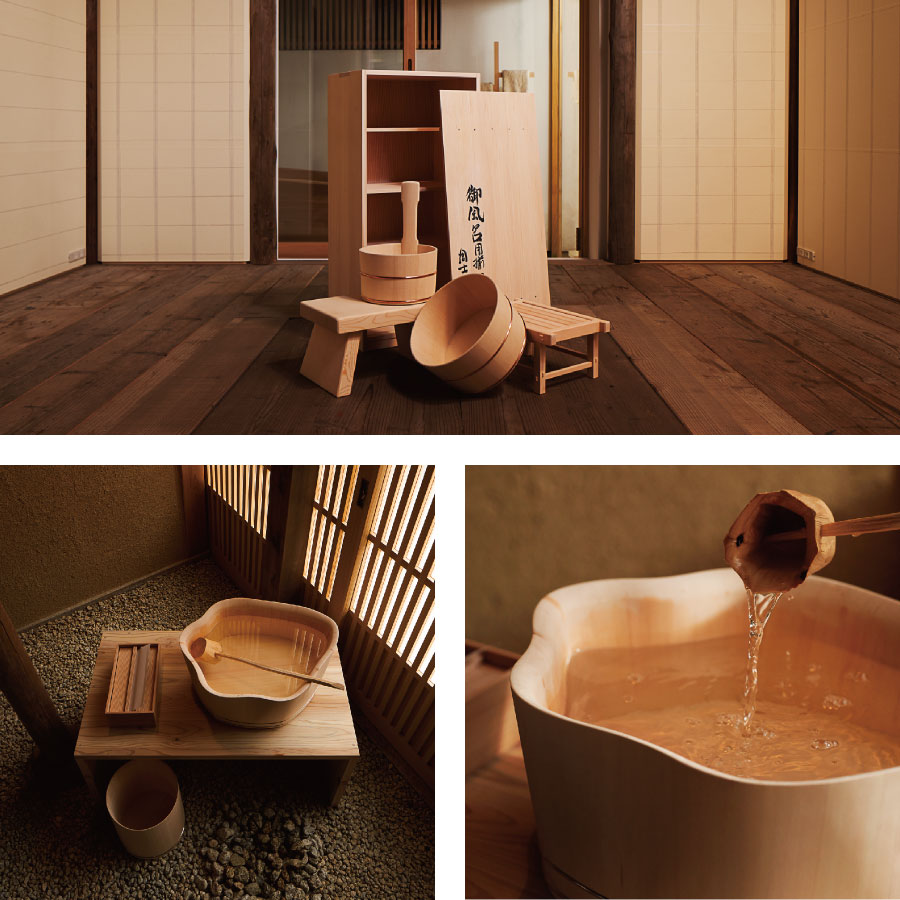
室町時代以前から京都や奈良などの都市に、入場料をいただいて人々を入浴させる「風呂」が出現しました。たまに、公家たちが数人で貸し切って酒宴を催したり、淋汗(りんかん)茶湯という、湯殿や湯槽を飾りたて、お茶を飲み、お話やお酒やお料理を楽しむながれのなかに「風呂」が使われるという大人の遊びが現れました。のちに、侘び茶の祖と言われる村田珠光も、若かったころ頻繁に出入りしていた寄合いが淋汗茶湯だったそうで、豪華に飾り付けられた混浴風呂で汗を流し、その後そうめんを食べ、抹茶の飲み比べをしたという記録が残っています。
KAIでも、KAI-RO(回炉)とKAI-TOU(回湯)を存分に使った遊びを考えています。例えばこんなEn-KAIです。
“Furo” baths, which let people bathe for a charge, appeared in cities like Kyoto and Nara before the Muromachi Period. Sometimes, groups of court nobles would rent out bathhouses to hold banquets and rinkan chanoyu gatherings, in which they would decorate bathrooms and baths, take tea, and enjoy talking and partaking in alcoholic beverages and cuisine. In this way, baths came to be used as accompaniments to adult pastimes. There are also records that later, Murata Juko, who is regarded as the founder of the wabi-cha style of tea, in his younger days frequented rinkanchanoyu gatherings, where he would perspire in gorgeously decorated mixed baths, eat somen noodles and partake in matcha drinking games.
KAI also aspires to let people enjoy themselves by using KAI-RO and KAI-TOU to their heart’s content.
Speaker: Shiro Miura Interviewer: Kanako Izumi
語り手 : 三浦史朗 書き手 : 和泉佳奈子
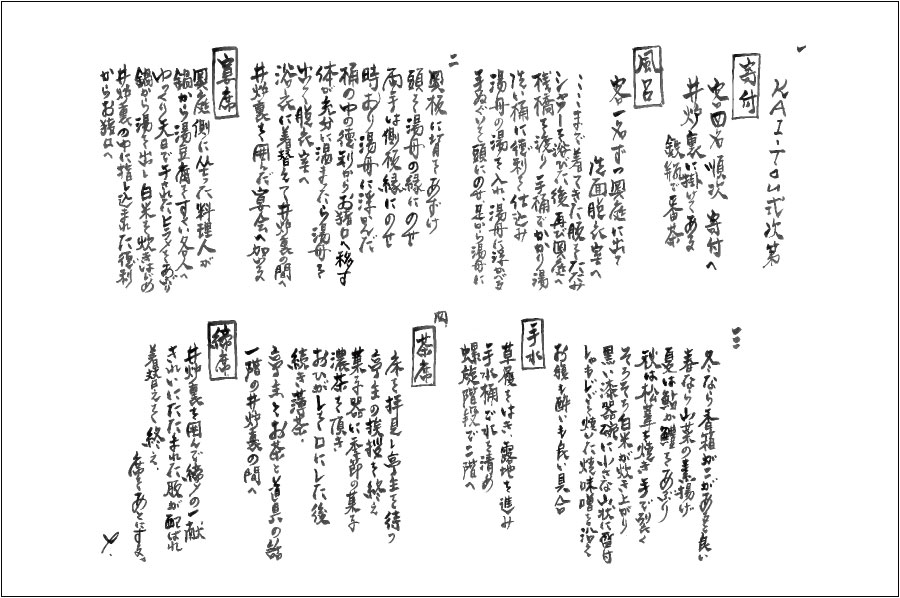
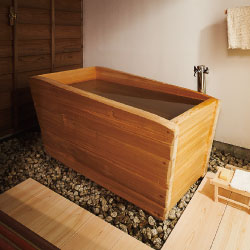

| 回湯 組立式湯船 | KAI-TOU Assembly Bathtub |
|---|---|
| サイズ:h620×w1400×d700mm | Size:h620×w1400×d700mm |
| 仕様:椹(さわら) | Specifications:Sawara cypress |
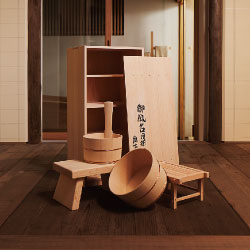
| 回湯 風呂道具一式 | KAI-TOU Bathing implements |
|---|---|
| 箱サイズ:h640×w310×d240mm | Box size:h640xw310xd240mm |
| 仕様: | Specifications: |
| ・片手桶:高野槇(こうやまき) | ・Hand pail:Japanese Umbrella-pine |
| ・丸湯桶:高野槇(こうやまき) | ・Round pail:Japanese Umbrella-pine |
| ・石鹸台:木曽檜(きそひのき) | ・Soap stand:Kiso cypress |
| ・腰掛け:高野槇(こうやまき) | ・Stool:Japanese Umbrella-pine |
| ・箱:樅(もみ) | ・Box:Fir |
